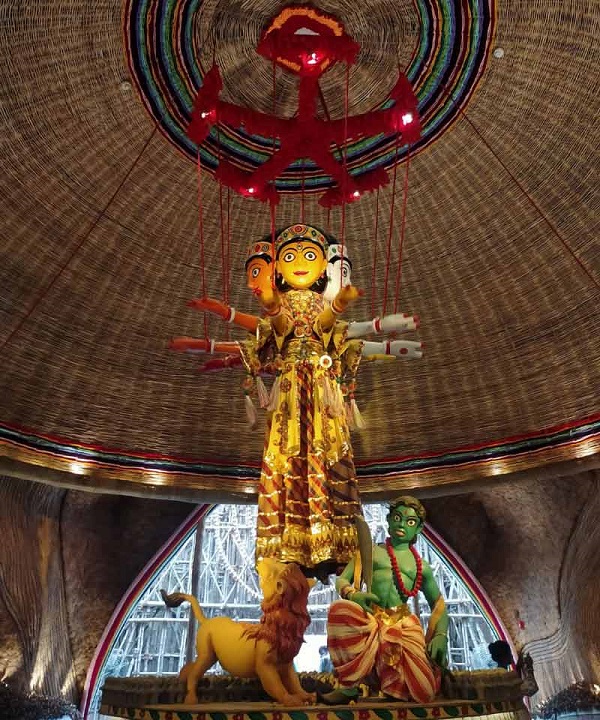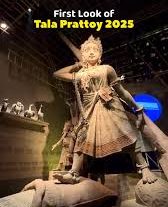Nestled in the heart of East Kolkata, Dum Dum Park Sarbojanin Durga Puja 2024 carved a deep impression on Kolkata’s festival landscape. Celebrating its 38th edition under the dynamic theme “Muktodhara” (The Stream of Liberation), the pandal was an evocative fusion of environmental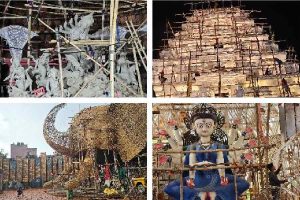 consciousness, Tagorian philosophy, and theatrical storytelling. With impressive visual artistry, poignant stage performances, and strong community involvement, this Durga Puja embodied the vitality of artistic purpose, social messaging, and spiritual devotion.
consciousness, Tagorian philosophy, and theatrical storytelling. With impressive visual artistry, poignant stage performances, and strong community involvement, this Durga Puja embodied the vitality of artistic purpose, social messaging, and spiritual devotion.
Theme Unveiled: “Muktodhara” – The Flow of Liberation
“Muktodhara”, derived from Rabindranath Tagore’s celebrated play, symbolizes transformation, nature’s resilience, and humanity’s attempt to tame—and heal—the environment. For Dum Dum Park as its 2024 theme, it became a cautionary tale: the damage caused by controlling nature, especially through hydraulic projects, and the eventual restoration that only freedom—of rivers, ecosystems, and communities—can bring.
The choice was timely. As the state confronts questions around urban expansion, climate change, and ecological balance, Muktodhara served as a metaphorical stream—inviting introspection and evoking responsible stewardship of resources.
Pandal Design: A Mountainous Canvas with Flowing Narrative
From the moment visitors approached, the structure unfolded like a sculpted mountain-range, with cascading cloth and layered fabric mimicking hilly terrains. At the center of the façade was a dramatic feature: a sculpture of Hari and Gauri locked in an eternal embrace, symbolizing union between man and nature, or technology and earth.
Within the pandal:
-
Unreal dams and impounded rivers, crafted using cloth and flexible pipes, suggested human attempts to control nature.
-
At ground level, flowing fabric channels mimicked rivers breaking free, reinforcing the concept of stream into liberation.
-
Lighting played a dramatic role: soft dawn hues transitioned to midday brilliance and dusk shadows—mirroring nature’s rhythms.
Visitors entered through a symbolic sluice gate, passing from artificial rigidity into open space around Durga’s idol. Every step was choreographed to evoke the narrative arc—control, tension, conflict, and resolution.
Live Performances: Tagore’s Muktodhara Comes Alive
This year, Dum Dum Park Sarbojanin elevated its experience with live enactments of scenes from Muktodhara. Actors portraying engineers, villagers, and riversfolk enacted the struggle between dam-builders and natural elements. Audiences moved from one set to another—under bridges, beside a plastic-sheened dam, near artificial waterfalls.
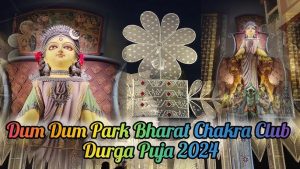 One actress played Bibhuti, the engineer, whose mechanical gestures echoed industrial ambition. Another recited Tagore’s monologues in Bengali and English, weaving poetic introspection into the public space. At regular intervals, performers invited audiences into brief interactive scenes—where they orchestrated button-presses to open floodgates or released water fabric into the “river”.
One actress played Bibhuti, the engineer, whose mechanical gestures echoed industrial ambition. Another recited Tagore’s monologues in Bengali and English, weaving poetic introspection into the public space. At regular intervals, performers invited audiences into brief interactive scenes—where they orchestrated button-presses to open floodgates or released water fabric into the “river”.
This living theatre added a bold dimension: combining Devotional space and environmental activism, making the puja an almost immersive performance art installation.
The Idol: Durga as the Liberator
Placed at the heart of this environmental narrative stood the Durga idol, crafted with mindful symbolism. Adorned in terracotta hues and natural motifs, the idol’s posture was neither regal nor passive—she seemed to stride forward, her lion at her side, ready to break chains. Her ten arms held traditional weapons, but also ecological elements—a sheaf of grain, a flame, a flower, a sapling.
The idol’s face was serene yet resolute, capturing the dual nature of the goddess. Instead of showing the demon Mahishasura, the symbolism focused on barriers—dams, walls, constraints—and their eventual dissolution.
This conceptual pivot—from destruction-of-evil to eradication-of-oppression—made Dum Dum Park’s Durga a liberator of both spirit and ecosystem.
Community & Social Impact: Beyond Rituals
Dum Dum Park’s strength has always been community involvement. In 2024, this extended beyond volunteers to include people with special needs, who operated food stalls and managed logistics—affirming the Puja’s embrace of inclusivity.
-
Teams organized health camps, dengue awareness drives, and road safety initiatives, investing grant money toward social welfare, in line with state encouragement for community Puja grants.
-
Authentic jams from local artisans, handicraft kiosks, book stalls, and eco-products filled the exhibition area, fostering economic support for neighborhood entrepreneurs.
These acts turned the festival into a community upliftment platform, seamlessly weaving social responsibility into celebration.
Eco Practices & Sustainability
Eco-consciousness was embedded throughout:
-
The pandal used bamboo, jute, organic dyes, and treated cloth instead of plastics or synthetic glitz.
-
Waste bins and recycling zones were set up; committees urged visitors to pick up paper, avoid plastic bottles, and reduce single-use items.
-
The club installed CCTV, smoke detectors, emergency kiosks, and prioritized fire safety and crowd management, especially given footfall exceeding 200,000 on peak days.
Local media praised the puja’s balanced approach—no elaborate digital gimmicks, but a disciplined, immersive sincerity that aligned with its powerful theme.
Cultural Programs: Tradition Meets Modernity
Uplifting performances decorated every evening:
-
Rabindra Sangeet recitals on nature-themed songs complemented the environmental theme.
-
Folk dance troupes depicted water rituals—goddess worship, river blessings, fishers’ traditions.
-
Children performed a puppet show on river ecology, while teens staged a short monologue on climate justice, interacting with visitors.
These performances offered education through culture, making Durga Puja a musical, educational, and reflective festival.
Broader Impact & Reflections
Beyond its own precinct, this puja set several examples:
-
Artisanship revival: younger artists, including women, contributed to design and execution, aligning with wider trends of increased female participation in puja arts.
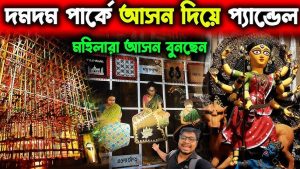
-
Translation of literature to physical art: Tagore’s Muktodhara became a living text, showing how literary classics can inform civic discourse through festive art.
-
Model for eco-friendly puja: other clubs are now adopting its bamboo-and-jute model.
-
Social integration: pug-of-support stalls run by specially-abled youth highlighted empowerment through celebration.
The festival also benefited from state-level funding: increased grants allowed committees to strengthen crowd control, health services, and safety measures—a reflection of cultural policy and civic planning.
Visitor Experience: A Day Inside Muktodhara
Imagine entering Dum Dum Park on Shashthi morning:
-
You pass through a fabric-wrapped sluice gate, step into a mountainous interior with rivers of silk swirling beneath.
-
An actor pauses near you, reciting Tagore’s verse as water soundscapes play.
-
As you stand before Durga, the idol seems suspended between earth and sky, powerful yet peaceful.
-
In the evening, children dance barefoot around a miniature dam installation, flanked by jamdani cloth banners fluttering in the breeze.
-
Nearby, a food stall run by special-needs youth serves local biryani; you talk to them, they beam with pride—part of the Puja’s communal soul.
This is not just a visit; it’s a journey through theme, ideology, and devotion.
Planning Your Visit: Practical Tips
-
Timing: Visit early (6–9 am) for tranquil rituals; late nights offer performances and soft lighting.
-
Accessibility: Pandal is spacious with rest zones; crowd control is robust.
-
Food & Shopping: Eco-stalls sell paper cups, vegan sweets, local crafts.
-
Stay hydrated and carry masks/hand sanitizer; safety teams and first‑aid kiosks are well placed.
-
Engage with performances—many let visitors join interactive segments.
Final Reflections: Dum Dum Park’s Legacy
In 2024, Dum Dum Park Sarbojanin Durga Puja reminded Kolkata that religion and activism can coexist, spirituality and environmentalism can thrive side-by-side, and art can be both beautiful and purposeful.
Muktodhara wasn’t just a theme—it was a message: that humanity must free the earth, just as rivers must flow freely. The festival became a celebration of liberation—not only of Goddess Durga but of nature, communities, and conscience.
As the dhak fades and the idol’s immersion concludes, Dum Dum Park’s creation lingers: in memory, in activism, and in our collective hope for a world where faith flows in harmony with nature, and where tradition carries wisdom for tomorrow.

